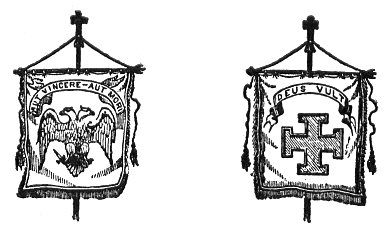
XXX.
KNIGHT KADOSH.
WE often profit more by our enemies than by our friends. "We support ourselves only on that which resists," and owe our success to opposition. The best friends of Masonry in America were the Anti-Masons of 1826, and at the same time they were its worst enemies. Men are but the automata of Providence, and it uses the demagogue, the fanatic, and the knave, a common trinity in Republics, as its tools and instruments to effect that of which they do not dream, and which they imagine themselves commissioned to prevent.
The Anti-Masons, traitors and perjurors some, and some mere political knaves, purified Masonry by persecution, and so proved to be its benefactors; for that which is persecuted, grows. To them its present popularity is due, the cheapening of its Degrees, the invasion of its Lodges, that are no longer Sanctuaries, by the multitude; its pomp and pageantry and overdone display.
In the 1800’s was a political party know as “The Anti-Masonic Party”, where many felt masonics ideals were too intertwined with society and politics and a strong political movement formed to overtake masonry, and to attempt to close Lodges and sway the populus from seeking membership in the fraternity. This was the means of ridding Masons in the United States. Across Europe at that time, the punishments for joining the Masonic fraternity were much more harsh, from prison sentences to even death.
But, as Pike writes in these paragraphs, this persecution purified Masonry as what was persecuted often GROWS. And Masonry did see more growth during and after that time in history.
Next
An hundred years ago it had become known that the ו ?Q?D?Sה were the Templars under a veil, and therefore the Degree was pro-scribed, and, ceasing to be worked, became a mere brief and formal ceremony, under another name. Now, from the tomb in which after his murders he rotted, Clement the Fifth howls against the successors of his victims, in the Allocution of Pio Nono against the Free-Masons. The ghosts of the dead Templars
haunt the Vatican and disturb the slumbers of the paralyzed Papacy, which, dreading the dead, shrieks out its excommunications and impotent anathemas against the living. It is a declaration of war, and was needed to arouse apathy and inertness to action.
An enemy of the Templars shall tell us the secret of this Papal hostility against an Order that has existed for centuries in despite of its anathemas, and has its Sanctuaries and Asyla even in Rome.
It will be easy, as we read, to separate the false from the true, the audacious conjectures from the simple facts.
In these paragraphs, Pike reminds the freemason of his roots in the Knights Templar. Tortured and murdered for (amongst other “crimes” against the Catholic Church) the audacity to think and worship freely without the constraints of old dogmatic beliefs.
This is the plight of the freemason. This is the duty of the freemason; to ensure that all people in society are indeed free to seek whatever truths benefit the individual, whether that truth is found in new or old ideals, religious or secular with the fear of persecution from the powers that rule over that individual be it government or merchant.
Let us never forget that many died to perptuate the rituals and ideas of freemasonry that we freely discuss and participate in today.
These next several paragraphs are written to impress upon the reader many different ideologies that have found persecution from religions or society, but have grown over time. I will want to cover those individually throughout the next several weeks, so we will end here with this foundation Pike set up in these beginning paragraphs.
Thank you for hanging in there with me. I hope this work means something to you and has helped you along the way in your masonic and “normal” life path.
Have a good week, I will see you next Sunday!

Comments
Post a Comment